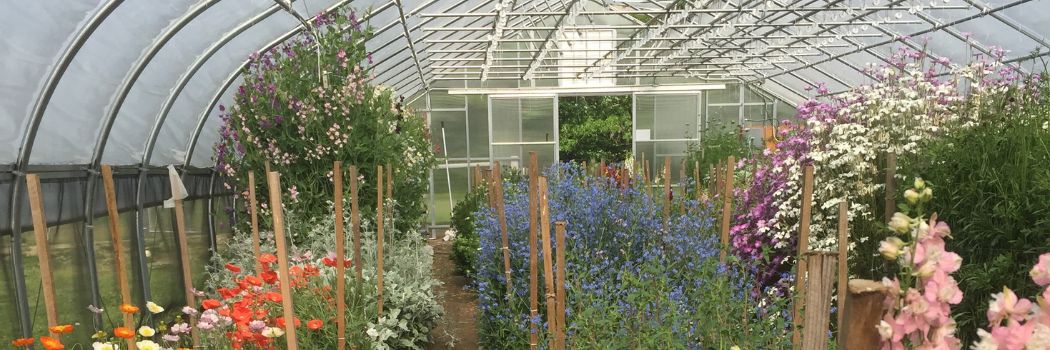- 3 Easy, Reliable, Productive Cut Flowers: Sunflowers, Zinnias & Rudbeckia
- 5 Factors That Determine Vase Life of Cut Flowers
- American Flowers Week: Combining the Art of Floral Design & Couture
- Celebrating the 8th American Flowers Week | Johnny's 2022 Botanical Couture
- Celebrate the 7th American Flowers Week | Johnny's 2021 Botanical Couture
- Collective Selling Models for Flower Farmers: Flower Hubs That Work
- 5 Cool Flowers to Plant Now | Lisa Mason Ziegler's Secrets for Growing Hardy, Cool-Season Annuals
- Cut-Flower Harvesting & Post-Harvest Care | Best Practices from Pros in the Slow Flower Community
- Cut-Flower Kit | Guide for Market Growers (PDF)
- Easy Cut-Flower Garden Map | For Growers New to Flowers (PDF)
- Easy Cut-Flower Garden Planner | For Growers New to Flowers (PDF)
- From Color to Climate: 5 Floricultural Trends Subtle & Seismic
- Flower Culture by Crop | Comparison Chart | Days to Germination, Weeks to Transplant, Days to Harvest (PDF)
- Flower Farmers' Favorite Fillers & Foliage | Recommendations from 3 Farmer-Florists
- Getting Started in Cut-Flowers | Top 15 Cuts
- Heat & Drought: How Flower Farmers Are Adapting to Changing & Challenging Climatic Conditions
- Intro to Overwintering Flowers | Method & Recommendations from Johnny's Overwinter Flower Trials
- An Introduction to Producer Marketing Cooperatives | M Lund & Associates
- How Day Length Affects Cut-Flower Production
- Flower Power for Roadside Markets
- Growing Flowers in Hoophouses & High Tunnels: Some Cool-Weather & Hot-Weather Options
- Tips for Starting a U-Pick Flower Operation
- Year-Round Flower Production Strategy
- Overwinter Flower Trials | Multiyear Results for >25 Crops | Johnny's Selected Seeds | XLSX
- Seeding Date Calculator | Johnny's Recommended Flowers for Overwintering | XLSX
- Just Add Flowers | An Introduction to Companion Planting for Vegetable & Herb Gardeners
- Sustainable Farming Methods | A Survey of Flower Farmers' Best Practices
- Pricing & Profitability for Flower-Farmers | Pointers from a Diversity of Pros
- Slow Flowers Palette & Petal Crushes | Evolving Colors & Shape-Shifts in Floral Industry Trends
- Johnny's & Slow Flowers | Johnny's Selected Seeds
- Slow Flowers | Celebrating Fifth-Season Regional Design Elements
- Slow Flowers Floral Forecast | A Summary of Industry Insights & Trends
- Slow Flowers | Building a Better Market Bouquet | Tips & Techniques for Flower Farmers
- Slow Flowers | Tips for Staging On-Farm Floral Workshops | Johnny's Selected Seeds
- Wedding Wisdom 101 | 10 Beginner Tips for Entering the Wedding Floral Landscape
- Succession-Planting Flowers | Scheduling & Planning, Sowing Frequency, Recordkeeping & Recommendations
- Succession-Planting Interval Chart for Flowers
- Sustainable Floral Design | Techniques & Mechanics for Foam-Free Floristry | Tobey Nelson & Debra Prinzing
- Video: Mason Jar Bouquet Tutorial
- Video: How to Build a Bouquet
- Video: Tobey Nelson | Sustainable Floral Design | Slow Flowers Summit
- Video: Economic Considerations in Overwintering Cut Flowers | Johnny's Selected Seeds
- Floral Stem Cutter | Instructions for Mounting, Use & Care | Tech Sheet (PDF)
- Top-10 Flowers for Direct-Seeding | 5 for Cool-Soil Sowing + 5 for Warm-Soil Sowing
- Video: Floating Row Cover | Baby "Cool Flower" Protection from Whipping Winter Winds
- Video: The Procona System for All-in-one Flower Harvest, Transport & Display
- Johnny's Overwinter Flowers Tunnel: Trellising, Supports, Ground Cover & Spacing
- Video: Irrigation Considerations for the Overwinter Flowers Tunnel | Johnny's Selected Seeds
- Video: Johnny's Overwinter Flowers Trial Recap
- Video: Producer Cooperatives for Small-Scale Farmers | Johnny's Webinar Series
- Climate Adaptation for Vegetable & Flower Farmers | Johnny's Educational Webinar Resources
- Webinar Slide Deck | Flower Growing in Southern States | PDF
- Bloom to Boom: Flower Farm Profitability
- Chrysal Professional 1 Hydration Solution | SDS
- Chrysal Professional 2 Transport & Display T-Bag | SDS
- Eat Your Flowers: Serve Up That Wow Factor With Edible Flowers
- Forcing Tulip Bulbs
- When to Start Seeds for Overwintered Flowers
- Introduction to Forcing Flower Bulbs in Soil
- Chrysal Clear Bulb T-Bag | Cut-Flower Conditioner | SDS
- Flower Growing in Southern States | Johnny's Educational Webinar Series
- Chrysal CVBN Flower Conditioner | SDS
- Video: Flower Growing in Southern States | Johnny's Webinar Series
- Chrysal Clear Universal Flower Conditioner | SDS
- Chrysal Clear Bulb Flower Conditioner | SDS
- Choosing Tulip Varieties for Forcing
- 10 Tips for Building a Profitable Cut-Flower Business
- Edible Flowers List: Top 20 Favorites from the Slow Flowers Community
- Choosing Flower Crops to Overwinter: Results from Our Trials
- Webinar Slide Deck | New-for-2023 Flowers & Floral Supplies | PDF
- Chrysal Classic Professional 2 Transport & Display (Holding) Solution | SDS
- Flowering in the South: Profiles of 5 flower farmers who cope with temperature, humidity, pest & weed pressure
- Chrysal Professional 3 Vase Solution Powder | SDS
by Lynn Byczynski, Author & Founder of Growing for Market
How long should cut flowers last in the vase? Cut-flower growers who sell at farmers' markets joke that the ideal vase life is 6 days — just long enough so the customer buys them each week. In truth, most growers aim for the longest vase life possible so customers will see their flowers as good value and come back again and again.
Here are the top 5 factors that determine vase life:
- The variety itself. Some flowers last a day, some last 3 weeks. Even within species, there can be big differences in vase life among types and cultivars. For example, single-stem sunflowers last several days longer than branching varieties. Various products are available to increase vase life, but there is, nevertheless, a maximum longevity for every variety. The Flower Farmer lists vase life for 100 commonly grown flower varieties.
- Stage at harvest. Most flowers can and should be picked before they are fully open, after which they continue to open in water. Picking at the optimally early stage gives the end-user a longer vase life than waiting until the flower is fully opened. Floral preservatives can help in this regard because they contain sugar, which helps sustain the flower as it continues to open and develop good color.
- Time of day at harvest. Flowers should be picked in the morning or evening; picking during the heat of the day makes it more difficult for the flower stem to uptake water, resulting in shorter vase life.
- Temperature and light after harvest. Flowers that are exposed to heat and direct sun after harvest will suffer. Some, though not all, can be stored in a cold cooler to prolong vase life. All will benefit from being held in an air-conditioned room, out of direct sunlight.
- Cleanliness. Once flowers are cut, they take up water through their stems. Bacteria can clog the stems, reducing water uptake and causing them to wilt prematurely. Therefore, it is imperative to reduce the chance of bacterial contamination. Anything that touches the flowers must be extremely clean — clippers, water, buckets, vases. Scrub everything before every use with soap and bleach, and let tools dry in the sun. If stems are dirty (after a heavy rain, for example), let the soil wash off in the picking bucket, then transfer the stems to a bucket of clean solution. Floral preservatives contain a biocide that kills bacteria, and can be used if cut flowers don't last long enough.
For more in-depth information, read our article on Cut-Flower Harvesting & Post-Harvest Care • Best Practices & Wisdom from the Slow Flowers Community …
Byczynski and her family have been growing vegetables and cut flowers since 1988, selling through CSAs, at farmers' markets, to chefs, grocery stores, and florists. They currently grow cut flowers and hoophouse tomatoes on about 2 acres of their 20-acre farm near Lawrence, Kansas.
She is also the author/editor of two of our favorite books about market farming, The Flower Farmer and The Hoophouse Handbook.



